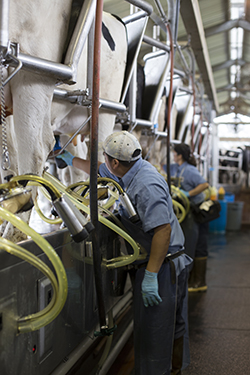 Mastitis remains the most prevalent health problem in dairy herds according to the USDA's Dairy 2014, and it's not one that is going away. The study found 24.1 percent of cows are affected by the disease. That number is up from the 16.5 percent reported in the 2007 National Animal Health Monitoring System survey.
Mastitis remains the most prevalent health problem in dairy herds according to the USDA's Dairy 2014, and it's not one that is going away. The study found 24.1 percent of cows are affected by the disease. That number is up from the 16.5 percent reported in the 2007 National Animal Health Monitoring System survey. Phil Cardoso, D.V.M., reminded farmers that as the mastitis rate goes up, so does the need for antibiotics. In a recent Dairy Focus at Illinois Newsletter, the assistant professor of animal sciences recommended dairies work to lower somatic cell counts (SCC) as a way of reducing antibiotic use and thus minimizing the chance for antibiotic residue in meat or milk.
He recommends the process of lowering herd SCC begins with reviewing protocols. The udder preparation process should focus on achieving clean, dry, and stimulated teats. In order to check this, he suggests swabbing the teat end immediately following preparation. A swab with residue of predip or dirt would score a 3 on a 0 to 3 scale, while a clean teat would score a 0. He said no more than 20 percent of teats should score 3.
The other, sometimes overlooked, protocol for evaluating SCC health is data analysis. Cardoso recommends closely monitoring dairy management programs and setting goals for herd-wide improvement based on recorded data.
"It is vital for antibiotic residue avoidance and low SCC that you consult with your veterinarian for a comprehensive and successful milk quality program," he said.
The great thing about SCC is that no matter how well-managed a dairy is, there is always room for improvement. What's your strategy?
 The author is an associate editor. She covers feeding and nutrition, youth activities and heads up the World Dairy Expo Supplement. Maggie was raised on a 150-cow dairy near Valley Center, Kansas, and graduated from Kansas State University with degrees in agricultural communications and animal sciences.
The author is an associate editor. She covers feeding and nutrition, youth activities and heads up the World Dairy Expo Supplement. Maggie was raised on a 150-cow dairy near Valley Center, Kansas, and graduated from Kansas State University with degrees in agricultural communications and animal sciences.







